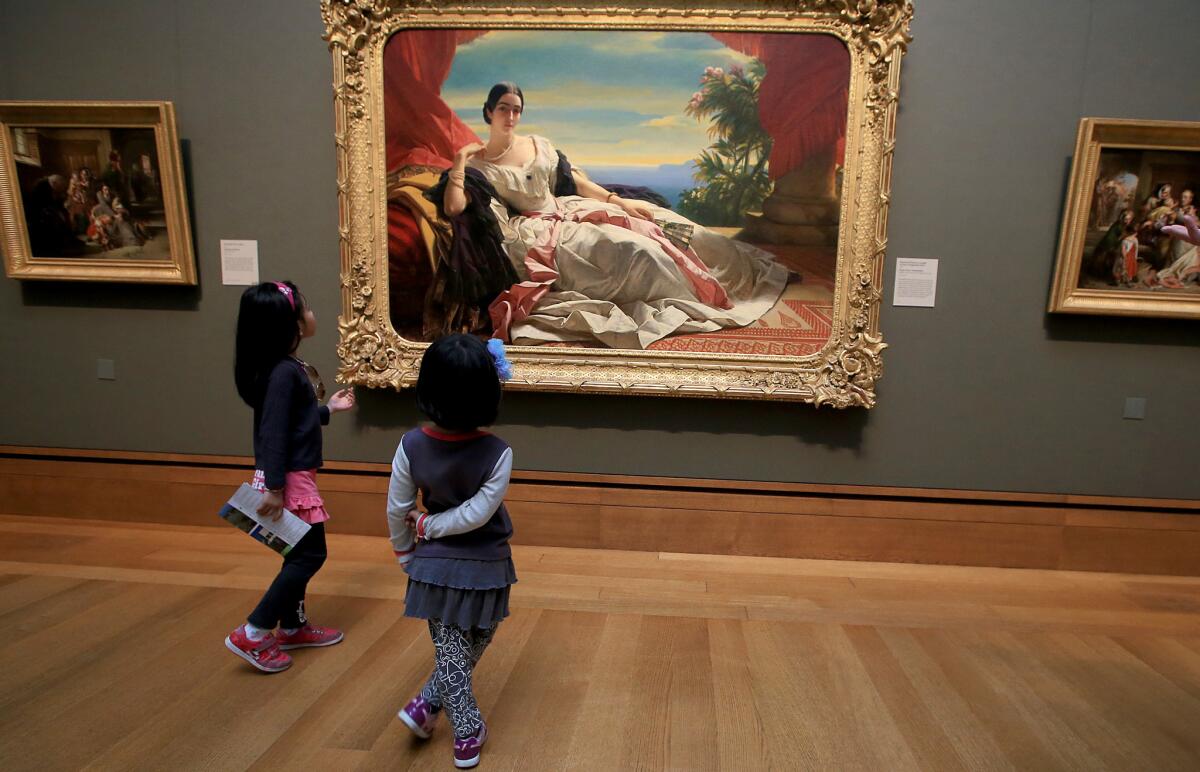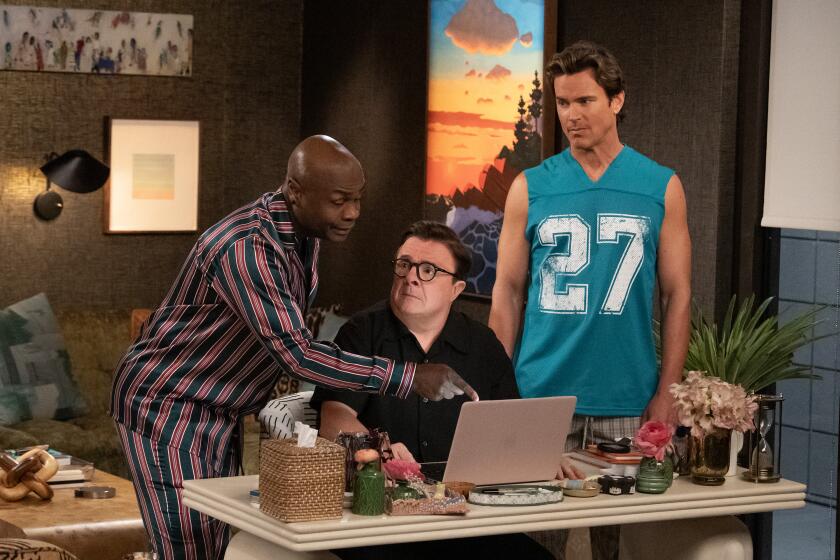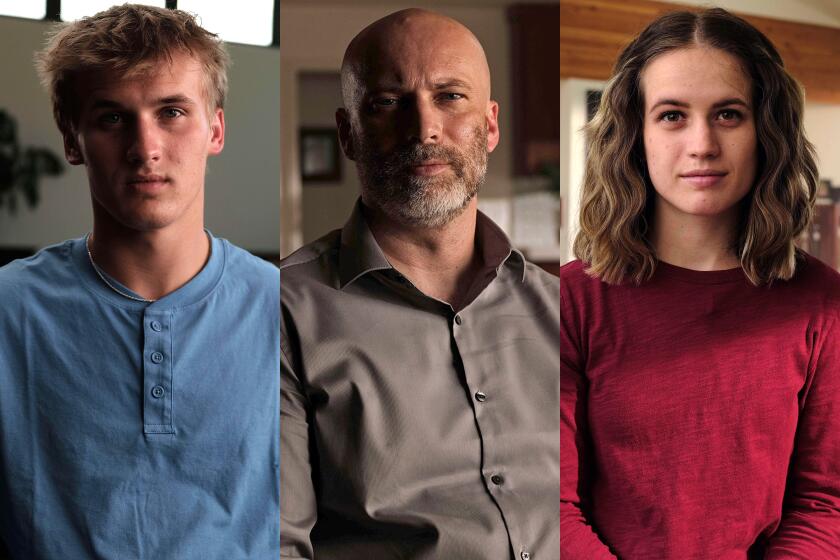L.A. museums sign on to ‘China Ready’ program in bid to draw tourists

Sisters Cynthia Ying, 5, and Diana Ying, 7, look at classical European paintings during a visit to the Getty Center in Brentwood on Feb. 17, 2015.
- Share via
Milly Wu marched through the J. Paul Getty Museum’s galleries of 19th century European paintings, stopping just long enough to frame Monets, Manets and, of course, Vincent Van Gogh’s “Irises” with her smartphone camera.
With a series of clicks, masterpieces became souvenirs to share with her friends back home in Hangzhou, China.
But when she reached the threshold of a gallery filled with opulent French furnishings from the reign of the Sun King, Louis XIV, the 11-year-old paused and let the camera dangle.
“Wah,” she gasped — Chinese for “wow.”
“It’s very beautiful,” said her dad, Will Wu, an information technology professional who used to work for Hewlett-Packard and speaks some English. “Mr. Getty had a great eye for this type of item.”
The Getty and other Los Angeles museums increasingly have their eyes on people like the Wus, who embody the rapid growth in tourism from mainland China. The Getty has taken the lead, aiming to leverage such advantages as free admission, a striking garden to go with the art masterpieces, and a tram ride to a hilltop perch in Brentwood that affords sweeping vistas of L.A.
To capture its share, the Getty recently engaged consultants in China who are helping it establish a presence on Weibo and WeChat, the leading social media sites for mainland Chinese. It also piggybacks on the Los Angeles Tourism and Convention Board’s efforts to promote an assortment of L.A. destinations for visitors interested in art and culture.
With a dozen other L.A. cultural organizations, most of them museums, the Getty has taken advantage of “China Ready,” a seminar program the tourism board launched last year to help businesses of all kinds become magnets for Chinese vacationers.
Those that complete the program are designated “China Ready” — a seal of approval they can use in overtures to the Chinese travel market.
Despite such efforts, not even the Getty seems likely to establish itself as a leading destination for group tours that send travelers through Southern California by the busload on itineraries usually planned by tour organizers in China. In 2008 the Getty Center became the first L.A. museum to host a pleasure-tour excursion group from the mainland after the People’s Republic of China lifted restrictions on nonbusiness travel. But U.S. tour operators who specialize in handling the logistics for big group tours say that the main draws, especially for first-timers in L.A., continue to be theme parks, Hollywood, excursions to Las Vegas and Yosemite, and spending sprees in luxury shops and outlet malls.
“The Getty is impressive, it’s beautiful. I think it’s a shame it’s not featured in the itineraries right now,” said Harry Chen, owner of Joy Holiday, a Bay Area-based company that regularly runs tours of L.A. “A minority of people are going to be interested in a museum. [Others] love to be at the most popular places, taking pictures.”
Daniel Shen, president of Temple City-based Lion Tours, said the dynamic is different for student groups that mainly come in the summer. “Every one of them that I handle from Asia requests the Getty Museum,” he said. Students typically come for longer stays and have time to explore L.A. in greater depth, he said, making a museum visit a natural.
Even without the big tour groups, the Getty and other art museums have a chance to attract increasing numbers of Chinese visitors — albeit more likely by the carload than the busload. “Free individual travelers,” a term for people who make their own arrangements and set their own itineraries, are seen as the future of Chinese tourism to the United States.
A new agreement with the People’s Republic is expected to generate many return trips: Instead of visas having to be renewed each year, with the waiting and expense that entailed, visas from China to the U.S. are now good for 10 years.
Visitors “will have time on their hands to discover places that fit whatever their interests are,” said Chen, the Bay Area-based tour operator. “The extension of the visas will really help places such as the Getty Museum.”
According to figures from the U.S. Department of Commerce, visits from mainland China to L.A. rose 20% in 2014. The numbers are expected to continue growing by at least 10% annually.
That explains why museums such as the Getty, the Los Angeles County Museum of Art, the Natural History Museum of Los Angeles County, the Huntington Library, Art Collections and Botanical Gardens in San Marino and the Norton Simon Museum in Pasadena have signed on to become “China Ready” after the program began last spring.
It involves sending staff members to at least three seminars sponsored by the L.A. tourism board. Once the coursework is done, cultural sites can win certification by launching an informational Web page in Mandarin, issuing Mandarin maps and guidebooks, and accepting China UnionPay, Chinese travelers’ favored credit card. Having staffers who speak Chinese is recommended but not required. Providing museum audio tours in Chinese and adding Chinese dishes to menus at food concessions are also desirable but not mandated. At the Getty’s cafeteria, visitors can get a menu in Chinese, and it usually will include a Chinese dish.
The Getty can’t say how many Chinese tourists it draws. The circumstantial evidence includes the 14,000 map-and-guide booklets in Chinese that were plucked from racks at the information booth in the Getty Center’s entry pavilion during the first three months of 2015. The Getty estimates it hands out about 100 audio devices daily that provide a guide to collection highlights in Mandarin.
Given L.A.’s substantial Chinese American community, including a recent influx of home buyers from the People’s Republic, and that many other Chinese speakers from around the world are not from mainland China, the booklets and audio tours are more of a hint than a measure of how many tourists from China are coming through.
New York’s Metropolitan Museum of Art — which tour operators say is a prominent destination for Chinese group travelers — estimates it had 209,000 visitors from China in fiscal 2013-14. Spokeswoman Elyse Topalian said that the estimate comes partly from visitor surveys and partly from figures reported by four major tour companies that regularly bring Chinese tourists to the Met.
But museum officials are sure that Chinese travelers contributed significantly to an overall increase in visitation at the Getty Center to 1,440,844 in 2014, the most since 1998 and 1999, when the site was new.
One faithful shepherd of Chinese visitors to the Getty is Seagull Holiday, a Monterey Park-based company that offers half a dozen tour itineraries in California, among them a daily bus tour of L.A. that includes a stop of about 100 minutes at the museum. Last year Seagull brought 12,561 visitors to the Getty, marketing manager Stanley Yu said, followed by about 1,300 in January and 4,000 in February, when vacationing surged for the Chinese New Year.
On a recent afternoon, a lemon yellow Seagull bus pulled into the Getty Center’s parking garage and let off 12 tourists from China and one young Argentine, none of whom had heard of the Getty Museum until they had set off on their day trip.
Tour guide Ethan Jiang gave a brief orientation, talking about the Getty’s architecture and leading the group to spots outdoors overlooking the garden and the vast views of the city. Then he brought them into the pavilion that features 19th century European paintings. After telling the group about other highlights elsewhere in the museum, Jiang sent his charges off to explore as they chose, armed with maps in Mandarin and instructions to be back at the bus at the appointed hour.
Le Xu of Beijing posed her husband, Hui Luan, beside Van Gogh’s “Irises” and took pictures. “I don’t know the painting, but I know the artist,” the young woman said in Chinese, with Yu, the Seagull marketing manager, translating. Like her husband, she’s studying to become a teacher.
“A few people know the Getty and join our city tour because of it,” said Yu, who emigrated from China 15 years ago when he was 13, brought by his father, a chef who had landed a job in L.A. As for the rest, he said, going to a scenic museum with a great art collection “is a good influence for them. Once in a while you have to go see different things, get a different view.”
Good influences were foremost in Will Wu’s mind when he asked a Chinese expatriate friend who lives in Los Angeles to recommend an art museum. Milly, the 11-year-old with the quick shutter hand, takes painting classes back home. This was a chance to foster her interest in art.
“My girl loves to see a lot of famous paintings, and my friend told me in the Getty Center there are a lot of famous paintings,” Wu said.
Which did Milly like best? Her face, which had been firm and intense while she moved through the galleries, rounded into a big smile as she answered in Chinese.
“She says she likes the irises,” her father said.
More to Read
The biggest entertainment stories
Get our big stories about Hollywood, film, television, music, arts, culture and more right in your inbox as soon as they publish.
You may occasionally receive promotional content from the Los Angeles Times.











